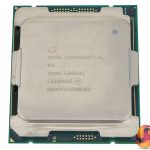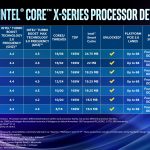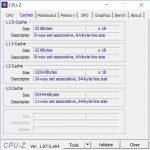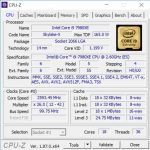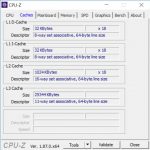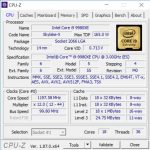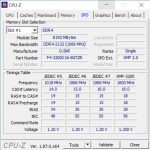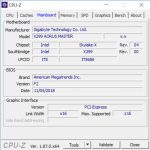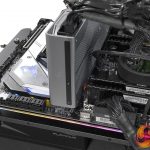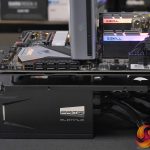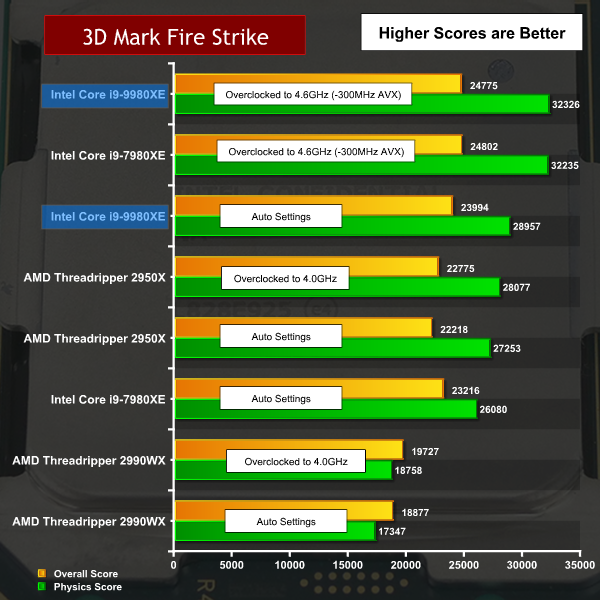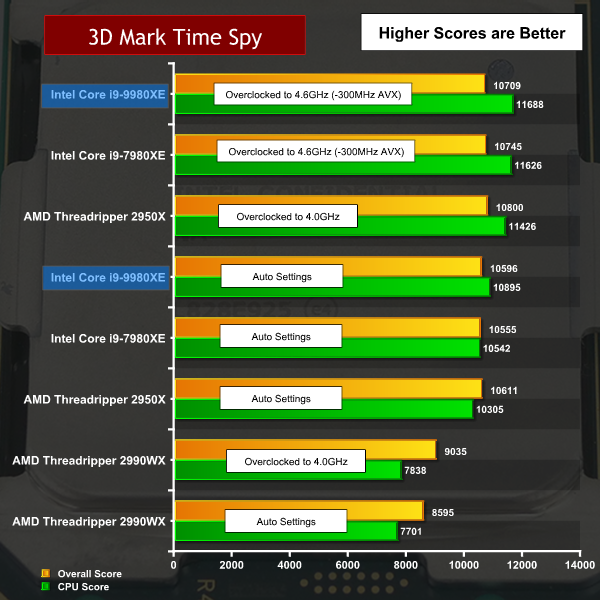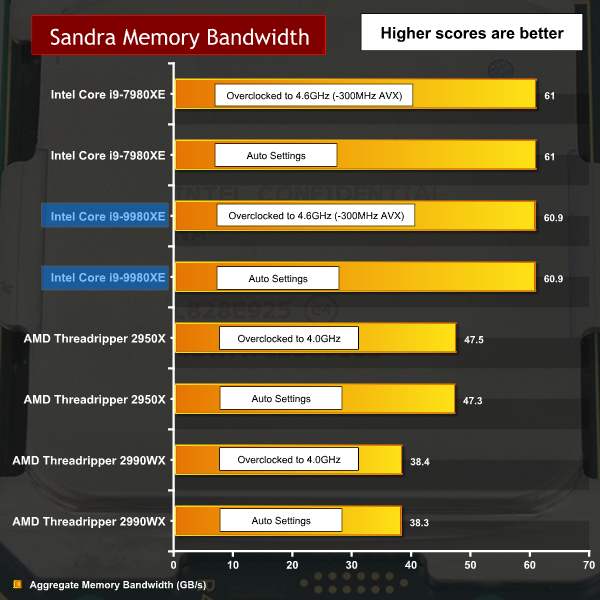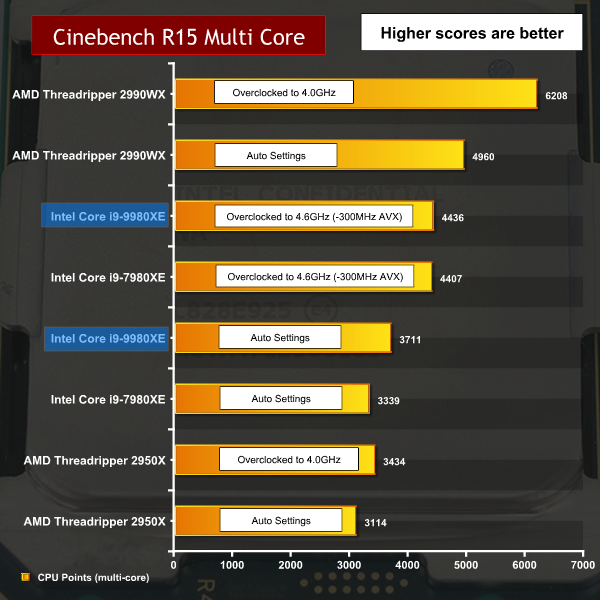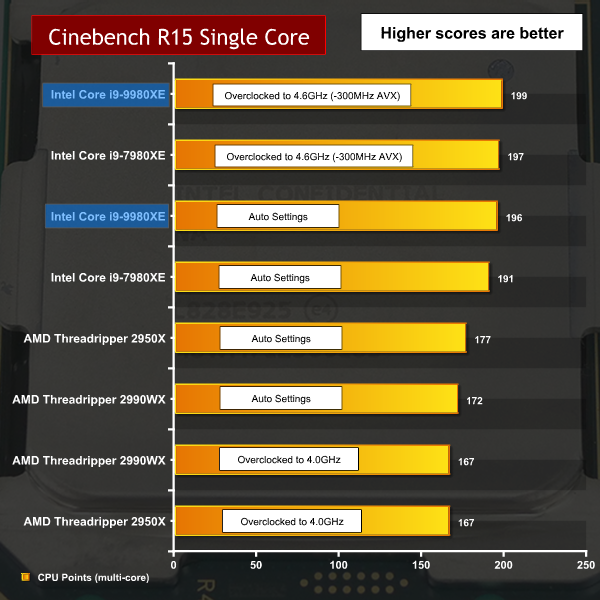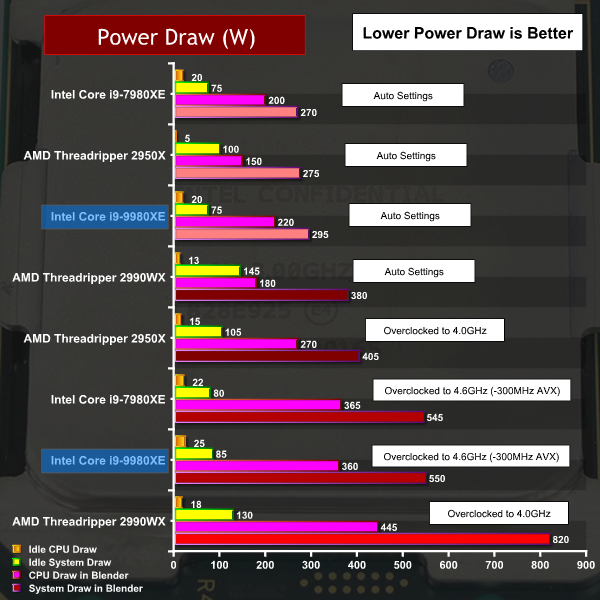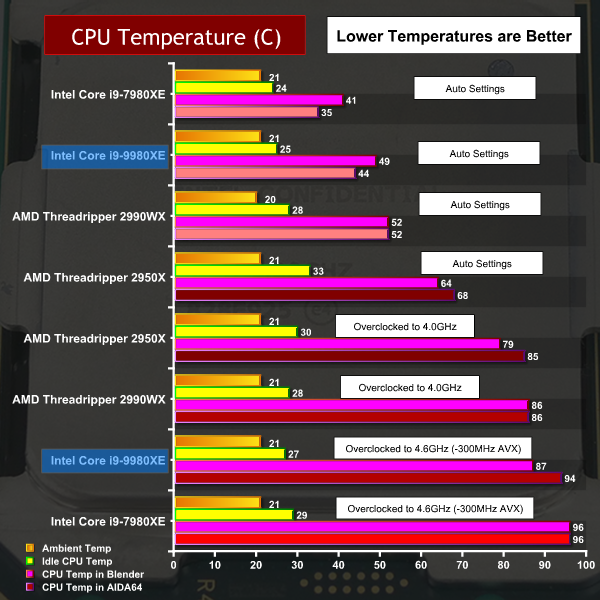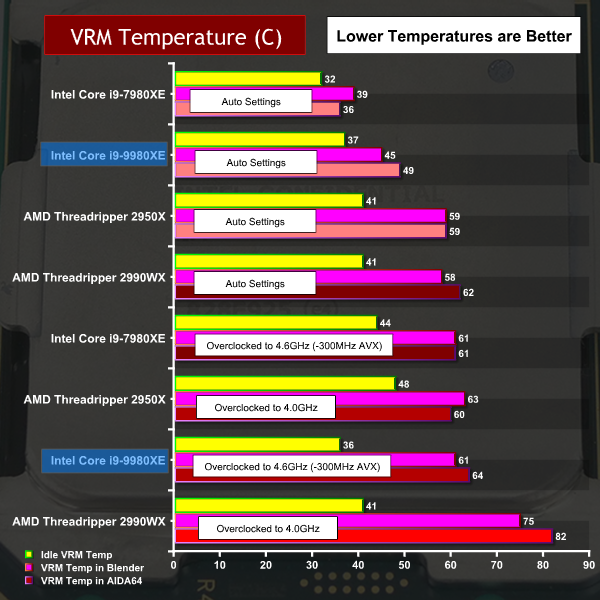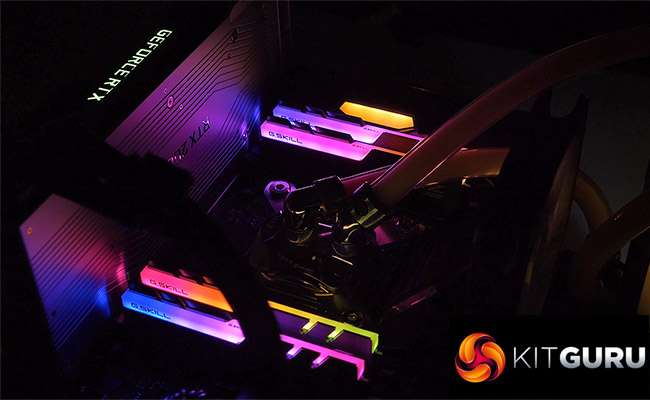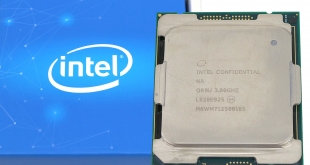
When Intel launched the 18-core Core i9-7980XE in September 2017 it was a clear response to AMD’s 16-core Threadripper 1950X. In 2016 we had got used to the idea of HEDT (High End Desk Top) CPUs with up to ten cores so Intel’s sudden jump to 18-cores was quite startling and also drove the price up to US$2,000. Fast forward another year to Intel’s recent New York briefing for Intel’s 9th Gen. Desktop CPUs, including the eight core Core i9-9900K and out of the blue we were also told about 9th Gen. Skylake X which included the 18-core Core i9-9980XE Extreme Edition.
On the face of it the i9-9980XE looked very similar to the preceding i9-7980XE with only modest changes to the clock speed and the welcome addition of a soldered heat spreader. Headline features that have been carried over from i9-7980XE to i9-9980XE are 18 cores/36 threads, 18MB total L2 cache (1MB per core), 24.75MB total L3 cache, 14nm fabrication process and an Intel list price of US$1,999. It was immediately clear the i9-9980XE did not truly deserve to be called 9th Generation as any changes looked more like detail revisions than significant updates. Nonetheless we could hardly wait to strap this new monster CPU to our test bench and see how well it performed.
| Intel Core X-series Processors | UK Price | Cores/Threads | Base Clock | Turbo Boost 2.0 | Turbo Boost 3.0 | Cache | TDP |
| Intel Core i9-9980XE | £2,270 | 18/36 | 3.0GHz | 4.4GHz | 4.5GHz | 24.75MB | 165W |
| Intel Core i9-7980XE | £2,000 | 18/36 | 2.6GHz | 4.2GHz | 4.4GHz | 24.75MB | 165W |
| Intel Core i9-9960X | £1,900 | 16/32 | 3.1GHz | 4.4GHz | 4.5GHz | 22MB | 165W |
| Intel Core i9-7960X | £1,400 | 16/32 | 2.8GHz | 4.2GHz | 4.4GHz | 22MB | 165W |
| Intel Core i9-9940X | £1,600 | 14/28 | 3.3GHz | 4.4GHz | 4.5GHz | 19.25MB | 165W |
| Intel Core i9-7940X | £1,050 | 14/28 | 3.1GHz | 4.3GHz | 4.4GHz | 19.25MB | 165W |
| Intel Core i9-9920X | £1,300 | 12/24 | 3.5GHz | 4.4GHz | 4.5GHz | 19.25MB | 165W |
| Intel Core i9-7920X | £1,000 | 12/24 | 2.9GHz | 4.3GHz | 4.4GHz | 16.5MB | 140W |
| Intel Core i9-9900X | £1,100 | 10/20 | 3.5GHz | 4.4GHz | 4.5GHz | 19.25MB | 165W |
| Intel Core i9-7900X | £1,050 | 10/20 | 3.3GHz | 4.3GHz | 4.5GHz | 13.75MB Shared | 140W |
| Intel Core i9-9820X | £1,000 | 10/20 | 3.3GHz | 4.1GHz | 4.2GHz | 16.5MB | 165W |
The specifications of 7th Gen. and 9th Gen. Core-X CPUs are very similar, although Intel has made a significant change beneath the surface that does not, ironically, have any impact on Core i9-9980XE. With the 7th Gen. HEDT part Intel used LCC (Low Core Count) silicon in the lower end of the range and HCC (High Core Count) silicon for the higher core counts. With 9th Gen. Core-X Intel has used HCC silicon throughout the Core-X range which means the models with 10- and 12-cores have gained a significant amount of cache memory. By contrast the 14-, 16- and 18-core models are unchanged in the cache department.
Intel’s release of Core i9-7980XE was a clear response to the 16-core Threadripper 1950X, however it was a very good response. The combination of 18 cores with higher clock speeds made for an impressive piece of hardware, despite the sky high price. By contrast Core i9-9980XE has arrived in a world where AMD has updated the 16-core Threadripper to the 2nd Gen. 2950X and has also released the 32-core 2990WX.
This makes life complicated as we need to take a step back and consider exactly what HEDT is all about. The first HEDT CPUs launched with prices that topped out at £650 with a core count that was one step ahead of the regular desktop parts used by gamers. Prices increased to £1,000 and then £1,500 with the 10-core i7-6950X, however the world of desktop CPUs started to shift when AMD debuted the Ryzen 7 1800X in March 2017 with 8-cores and clock speeds around 4GHz. This was a convincing riposte to the quad core Kaby Lake i7-7700K, however AMD Threadripper 1950X was the CPU that really changed things in the summer of 2017.
AMD’s radical new approach to CPU design meant they were able to update Threadripper extensively in 2018 to such an extent the £800 Threadripper 2950X qualifies as HEDT while the Threadripper 2990WX is in a class of its own. On the one hand the £1,600 price tag falls plumb in the middle of the Intel Core-X range that stretches from £1,000 to £2,270, but on the other hand the 32 cores make the 2990WX superb in CPU-intensive workloads. Conversely Threadripper WX is unimpressive in general purpose duties such as gaming.
Performance and Overclocking
We started testing our Threadripper 2950X and 2990WX CPUs before the Core i9-9980XE had arrived so we could get our baseline test results ready. We used a Fractal Design Celsius S24 AIO liquid cooler on our AMD test system that performed perfectly well, however by the time we came to test the Core i9-9980XE and re-test the Intel Core i9-7980XE we had heard reports that Core i9-9980XE ran considerably hotter than we expected.
We had rather supposed the addition of a soldered heat spreader would reduce temperatures of the 9980XE, compared to the 7980XE, and had fully intended to use the Celsius S24 to demonstrate that Intel’s new 18-core CPU had tamed the technology. You can practically see the headline writing itself there.
By the time we started testing we understood that Intel had worked on the clock speed of the i9-9980XE and had left power and thermals essentially untouched so we decided it was best to upgrade the CPU cooler to a 240mm custom loop. This was built using an Aqua Computer Cuplex Kryos NEXT CPU block, a Watercool Heatkiller IV Tube and D5 pump/reservoir and an Alphacool NexXxos ST30 240mm nickel plated radiator.
Intel test system:
CPU: Intel Core i9-9980XE and Core i9-7980XE
Memory: 32GB G.Skill TridentX DDR4-3200MHz Quad Channel
Motherboard: Gigabyte X299 Aorus Master
CPU cooler: Fractal Design Celsius S24
Graphics: Nvidia RTX 2080 8GB Founders Edition
Storage: Samsung 960 PRO
Power Supply: Seasonic Prime Platinum 1300W
OS: Windows 10 Pro
AMD Threadripper test system:
CPU: AMD Ryzen Threadripper 2990WX and 2950X
Memory: 32GB Corsair Vengeance LPX DDR4-3200MHz Quad Channel
Motherboard: Gigabyte X399 Aorus Xtreme
CPU cooler: 240mm custom loop
Graphics: Nvidia RTX 2080 8GB Founders Edition
Storage: Samsung 970 EVO
Power Supply: Seasonic Prime Platinum 1300W
OS: Windows 10 Pro
Cooling components:
CPU block: Aqua Computer Cuplex Kryos NEXT
Pump/reservoir: Watercool Heatkiller IV Tube and D5
Radiator: Alphacool NexXxos ST30 240mm Nickel Plated
Fittings: EKWB 16/10mm
Tubing: Mayhems Ultra Clear16/10mm
Coolant: EKWB CryoFuel Solid Laguna Yellow
Performance and Overclocking Overview
Depending on which benchmarks you focus, these charts could deliver shocking results – however if you have been paying attention you can very likely guess what is coming next. Core i9-7980XE previously topped the charts in general tasks such as 3DMark and Core i9-9980XE raises the performance levels ever so slightly. We have no doubt the 9980XE is better than 7980XE but these results do not look like two different CPUs. Instead it feels like 9980XE is a 7980XE that came out of a better bin and delivers slightly higher performance.
In 3DMark Time Spy there is essentially no difference between 7980XE and 9980XE but when you look at 3DMark Fire Strike you can clearly see the Core-i9 9980XE pulls ahead on Auto settings thanks to those extra Megahertz. When we overclocked the two Intel CPUs we found the best speed was 4.6GHz on all cores for both CPUs and as a result performance of the two CPUs was pretty much identical.
What you are seeing here is the advantage that Core i9-9980XE brings in non-AVX workloads when you run the Intel CPUs on Auto settings. Non-AVX speeds are 3.8GHz for the i9-9980XE and 3.4GHz for i9-7980XE so for gaming the new CPU has an advantage.
Comparing the Intel CPUs to AMD we see that Threadripper 2950X does a decent job but loses out in straight performance. Clearly there is an argument to be made about value for money but in these tests Intel wins and AMD loses. The 32-core Threadripper 2990WX loses badly in 3DMark, however we expected nothing less.
Switching to CPU tests such as Cinebench and Blender shows the i9-9980XE once again has the lead over i9-7980XE on Auto settings. When the CPUs are overclocked to the same speeds they perform in an identical manner. This time, however the Threadripper 2990WX crushes Intel by a significant margin. Those 32 cores run at slower clock speeds than the 18 cores packed by Intel, however there are so many cores that they make mincemeat of the benchmarks. It simply doesn’t matter that AMD has no support for AVX-512 instructions as Threadripper steamrollers its way through the tests at a monstrous pace.
Power Consumption
We monitor CPU power draw using Powenetics project software from Cybenetics which means we are able to monitor both the overall system power and also the power that is feeding directly to the CPU cores.
Power Consumption Overview
If you are in the market for a Threadripper WX our chart will show you the downside as that huge number of cores requires plenty of power. When you overclock Threadripper WX the power draw more than doubles and indicates that Auto settings make the most sense unless you have extreme requirements for CPU performance.
At stock clock speeds Core i9-9980XE draws some 20W more than Core i9-7980XE under load, which is a simple reflection of the higher core voltage and increased clock speed. When both CPUs are overclocked to 4.6GHz the power figures equalise, exactly as you would expect.
Temperatures
Temperature Overview
You can draw a number of conclusions from our temperature chart, however we doubt you would guess the i9-9980XE is packaged differently to the i9-7980XE. It is quite bizarre how the use of a soldered heat spreader makes very little difference to the thermal performance of the 18-core CPU.
The one area of difference we can see comes when we overclocked both CPUs to 4.6GHz and then hammered them in Blender as the i9-9980XE remained below 90 degrees while i9-7980XE was desperately close to 100 degrees.
It is clear that Intel has used every last scrap of thermal headroom to raise performance to the limits. Flipping this the other way around, it wouldn’t have made much sense to release i9-9980XE at the same clock speed as i9-7980XE with lower temperatures saying ‘look, it runs cooler’ however the results look unimpressive on the page and especially when you run both CPUs on Auto settings.
Intel Core i9-9980XE Extreme Edition claims to be a 9th Generation CPU, however it is clearly a repackaged Core i9-7980XE with different voltage and speed curves that has been topped off with a soldered heat spreader. When we compare the two CPUs on Auto settings you can see the new model runs slightly faster, draws more power and is hotter.
When you overclock both CPUs to 4.6GHz it is very difficult to tell the two chips apart although the thermals of the i9-9980XE are somewhat better under extreme load.
We are not clear why Intel released this family of ‘9th Gen.’ Core X processors, although it seems likely the explanation is that 7th Gen. looks rather elderly now that Coffee Lake Refresh has led the way to 9th Gen. Intel required a new range of Core X CPUs and their well documented problems with 10nm meant we were looking at a rebadging job, rather than a complete overhaul.
The disappointing thing here is that comparing one 18-core CPU with another highlights how similar they are, and also begs comparison with Threadripper 2950X and 2990WX, which doesn’t end well for Intel. That same comparison ignores the changes Intel has made further down the stack where we understand they have moved from LCC silicon to HCC.
For example the 10-core Core i9-9900X now comes with 19.25MB cache which must surely yield some advantage over the Core i9-7900X with 13.75MB, and in addition you get those slightly higher clock speeds and the soldered heat spreader.
The other problem with the Core i9-9980XE is that the price completely ignores the existence of Threadripper. On the one hand you can buy the 16-core Threadripper 2950X for about 40 percent of the price of i9-9980XE or you can buy the 32-core 2990WX and a high end X399 motherboard for the same price as the bare Intel CPU.
It is quite easy to make the case that Core i9-9980XE is a better all-round CPU than Threadripper but who the heck would buy this 18-core monster for email, browsing and shopping on Amazon? It is clearly a CPU that is intended for serious work so you should have no difficulty deciding which specific Threadripper suits your use case. If you have any interest in the value of money we doubt that Core i9-9980XE will be the answer to your particular question.
Looking at the bigger picture we have to think the days of monolithic chips are numbered. We have yet to see the 28-core Intel Xeon W-3175X or the 48-core Cascade Lake AP but these will surely be the end of that technical approach.
Perhaps Intel will work some magic with a new fabrication process but right now it seems their new Foveros approach with 3D chip stacking is the future, while Core i9-9980XE belongs in the past.
You can currently pre-order the i9-9980XE from Overclockers UK for £2269.99 HERE.
Pros:
- Massive all-round performance.
- A simple upgrade for anyone currently using the X299 platform.
- Excellent compatibility with a range of DDR4 memory.
- Supports AVX-512 instructions.
- Better thermals than i9-7980XE when you overclock.
Cons:
- Offers minimal performance benefits over i9-7980XE.
- Pure CPU tests show the advantage of Threadripper 2990WX.
- Brutal power draw when you overclock to the maximum.
- Very expensive when compared with AMD Threadripper.
KitGuru says: Intel has created Core i9-9980XE by giving 7980XE a couple of minor updates. In the meantime AMD has given Threadripper a radical overhaul and the result is that Core i9-9980XE looks outdated and expensive.
Be sure to check out our sponsors store EKWB here
 KitGuru KitGuru.net – Tech News | Hardware News | Hardware Reviews | IOS | Mobile | Gaming | Graphics Cards
KitGuru KitGuru.net – Tech News | Hardware News | Hardware Reviews | IOS | Mobile | Gaming | Graphics Cards


